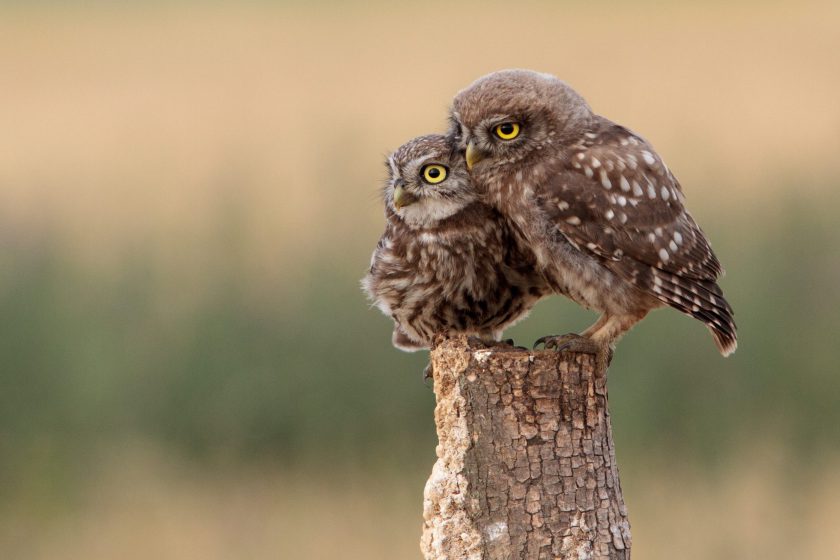As birds of the family of Strigiformes which include over 200 known species, the owl mostly a solitary and nocturnal bird of prey is characterized by its upright stance, binocular vision, feathers adapted for silent flight, broad large head and binaural hearing. Exceptions to the order include the gregarious burrowing owl and the diurnal hawk-owl. The family of owls is primarily divided into two orders recognized as the barn-owls, Tytonidae and the true owls or Strigidae.
Owls are known to mostly hunt other birds, insects and small mammals for prey, however there are a few species are known for hunting fish. Owls are primarily found in most regions of the world with the exception of Antarctica as well as some other remote islands.
Facts About Owls
▪ Owls are known to have forward facing eyes, a hawk-like beak, ear-holes and a flat face and generally a noticeable circle of feathers sometimes referred to as a facial disc around each eye. The feathers used to make up these facial discs can be adapted to allow the owl to focus sharply on sounds occurring from varying distances to its asymmetrically positioned ear cavities. Contrary to most birds of pray with their eyes positioned on the sides of the head, the owl with its stereoscopic nature has its eyes facing-forward allowing a heightened sense of depth awareness for hunting in low-light.
▪ In spite of the owl known for its binocular vision, their eyes similar to other birds are fixed in their sockets requiring them to turn their entire head for a change of view. Notably although owls are farsighted particularly in low light, they somewhat are limited in their vision when focussing on objects seen just a few centimeters in front of them. Thus the owl’s prey when caught is generally felt with the use of the its hairlike feathers on its beak that function as a type of “feelers”.
▪ Compared to humans with seven neck vertebrae owls are known to have fourteen neck vertebrae making their necks much more flexible allowing the species to rotate their heads and neck as much as up to 270 degrees due to natural adaptations to the owl’s circulatory system which allows the owl to rotate its head without experiencing a cerebral infarction.
▪ The smallest species of the owl known as the elf-owl weighs about 1 oz measuring about 5 inches, whereas the largest owl by length is known as the great grey owl and can measure as much as 33 inches. The heaviest and largest winged owls however are the Eurasian eagle-owl and the Blakiston’s fish owl, both eagle owls of similar size with an average length of 2.53 centimeters and a wingspan of about 7 feet and weighing about 10 pounds.
▪ Owl eggs generally white in color, almost symmetrical in their shape and can range in number from a few eggs to as much as a dozen, relative to the species of the owl and the season. Females are known for laying their eggs at intervals of 1 to 3 days hatching independently.
▪ Although most owls are nocturnal and hunt their prey primarily in darkness, there are a few species of crepuscular owls such as the small pygmy owl sometimes called “owlets” known to hunt mainly large insects and other small prey during twilight hours of dusk and dawn.
▪ While all owls are carnivorous birds of prey mostly known for their diet consisting of insects and small rodents such as hares, rats and mice, some owls have adapted to hunt fish as a source of food and as they are adept in hunting respective to their environment across a multitude of ecosystems some characteristics can be seen to vary slightly accordingly with each known species.
▪ Due to the coloration of the owl’s plumage, the species is able to remain still and effectively blend into its environment as a from of camouflage becoming almost invisible to its prey.
All About Birds Livestream Webcam
Founded as a nonprofit organization in 1915 the Cornell Lab of Ornithology has become a leader in the appreciation, study and conservation of birds across the world. Accredited with the hallmark of excellence in science and technological innovation the Cornell Lab of Ornithology has continues to aid in advancing the knowledge of wildlife by engaging individuals of all ages to learn about birds and their importance in the protection of the planet.
Via the online website www.allaboutbirds.org the Cornell lab of Ornithology Bird Cams section features a number of live webcams offering visitors a close up look at a number of birds including their resident Barn Owls shown in the link posted below.
View Texas Barn Owls Webcam.
Somerset Wildlife Trust Owl Webcam
The Somerset Wildlife Trust maintains over 70 nature reserves across more than 1,700 hectares in Somerset, England. Many of their reserves offering visitors and residents free access to enchanting wildlife meadows, stunning wetlands and woodlands are open tear-round.
The Somerset Wildlife Trust Barn Owl Project launched in spring 2012 recognizes more than 280 parishes coming forward to participate in the project by each parish hosting a barn owl nest as a conservative initiative to increase the number of barn owls in the count by providing the species with adequate nesting sites. Viewers to the Somerset Wildlife Trust website can watch a live steam of the resident barn owls at one of the nesting sites.
View Somerset Wildlife Trust Live Barn Owl Next Box Webcam.
The Feather Rehabilitation Center Owl Webcam
The Feather Rehabilitation Center, New London, Wisconsin was founded in 1987 as a nonprofit organization dedicated to the care of injured and orphaned wildlife.
The Center via their USTREAM channel offers online viewers a close up of their resident great horned owl named Ms Harvey shown in the link provided below.
View Ms Harvey the Great Horned Owl webcam.

